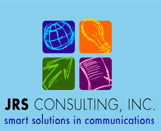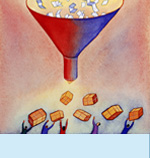


  |
||||
|
PRINTER FRIENDLY VERSION "What's In It For Me?" Guidelines for Developing Compelling Communications and Messages Do your communications messages hit a bull's eye with your target audiences? While testing messages in focus groups for a large retail chain that wished to improve its image as an employer, we reviewed themes identified as important by the communications department. These included the fact that the organization sponsored a sporting event to raise funds for a major charity each year. "That's very nice of them to do," noted a prospective employee, "But it doesn't make me want to go work there. What's in it for me?" An "aha" moment for the communications department — the most meaningful messages for their target audiences went beyond "nice to know." The most compelling messages were those that directly impacted current and potential employees. For the retail chain, these messages involved providing employees with flexible work hours and formal on-the-job training. Are your messages compelling? What, if anything, do they mean to your key stakeholders? Even the highest quality, most professionally produced communications program and materials will fall flat if their contents aren't meaningful to their intended audiences. Testing messages through focus groups or interviews allows us to explore the core values and motivations that drive how employees and consumers respond to corporate positioning and branding. On a practical level, we can also test the message language. Is it clear? Is it believable? Is there a better way to say it? Subtle nuances can make all the difference in message development. For example, when we tested messages among first- and second-graders for a youth organization, kids responded negatively to the idea that the club offered them a chance to do things they hadn't known they could do. "That sounds scary," a young boy explained, "I might get hurt." However, when we revised the message to convey that kids could try activities they didn't usually get to experience, focus group respondents responded positively, "Awesome!" For seven- and eight-year-olds, the world can be a daunting place. Feeling competent — and looking cool in front of peers — can make all the difference when it comes to choosing which after-school organization to join. This subtle difference was an "awesome!" finding for our youth organization clients as they developed their marketing materials. We have tested messages among audiences that include corporate staff, company employees, customer groups, children, parents, retirees, physicians and nurses. While our techniques are often tailored to specific audiences, we note similarities across groups that can be very useful in the development of impactful messages. Following are 10 guidelines for developing meaningful messages that we have developed, based on conducting research in hundreds of focus groups during the past 10 years: 1. Use examples or stories whenever possible. They improve credibility and put a human face on the organization conveying the message. For example, if a bank says it provides opportunities for advancement, describe the former teller who is now vice president of commercial lending. 2. Focus on benefits to the end user. Do you have a focus on safety? Explain how this focus has increased workers' or customers' well being. 3. Don't overlook the value of heritage. Have you been selling turkeys for 50 years? Bourbon for 200 years? Talk about it. Being in business for a significant length of time tells customers they can count on you. "They must be doing something right," we frequently hear in our focus groups, "This lets us know they'll be around if we need them." 4. Avoid superlatives, like "the best" or "the only." People are suspicious of these claims. Use stories to demonstrate leadership. Back up claims with data and examples. 5. Use specifics in communications to bring the message to life. For example, explain that "unique work-life benefits" means a 4-day work week, a corporate nanny- finder service or an optional "work at home" day when children are ill. 6. Tailor messages to your audience so that they can see themselves in the message. This might mean localizing examples to a regional area, such as "Here at the Madison plant," or offering examples that resonate for a particular profession or business unit. 7. Bring your corporate vision, mission and values to life for employees. If your vision is, "Count on us," tell each business unit specifically what customers are counting on them to do. Move beyond the wallet card that states the vision to highlighting what employees are doing to implement corporate initiatives in their daily jobs. 8. Keep in mind that external audiences often define words differently than employees. It's fine to refer to hotel employees as guest consultants in internal publications, but the term may be confusing in outside media. Be as clear and concise as possible. 9. If your audiences include ethnic groups, test messages in those languages and cultures as well. Our multi-cultural team of researchers test messages in Spanish and across ethnic groups to ensure we understand cross-cultural sensitivities. 10. If your organization is global, be aware of potential anti-American sentiments outside of the U.S. It's easy to come across as boastful and omnipotent in message content. Gear message language towards focusing on how your organization benefits local citizens. The overriding benefit of message testing is ensuring that all communications reflect messages that we know are meaningful to key constituents. In other words, the resources that you devote to message testing now will pay off in spades when you move forward with producing communications programs and materials that hit the mark. Identifying how stakeholders respond to what the corporation has to say is the lifeblood of designing communications that attract and retain both customers and employees. NEXT ARTICLE Jenny Schade is president of JRS Consulting, Inc., a firm that helps organizations build leading brands and efficiently attract and retain employees and customers. Subscribe to the free JRS newsletter on www.jrsconsulting.net/newsletter.html © JRS Consulting, Inc. 2007 |
 |
|||
© 2008 JRS Consulting, Inc.